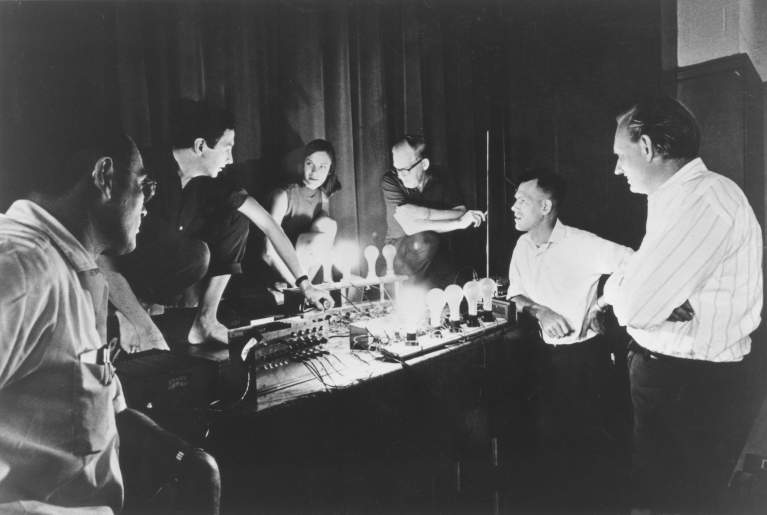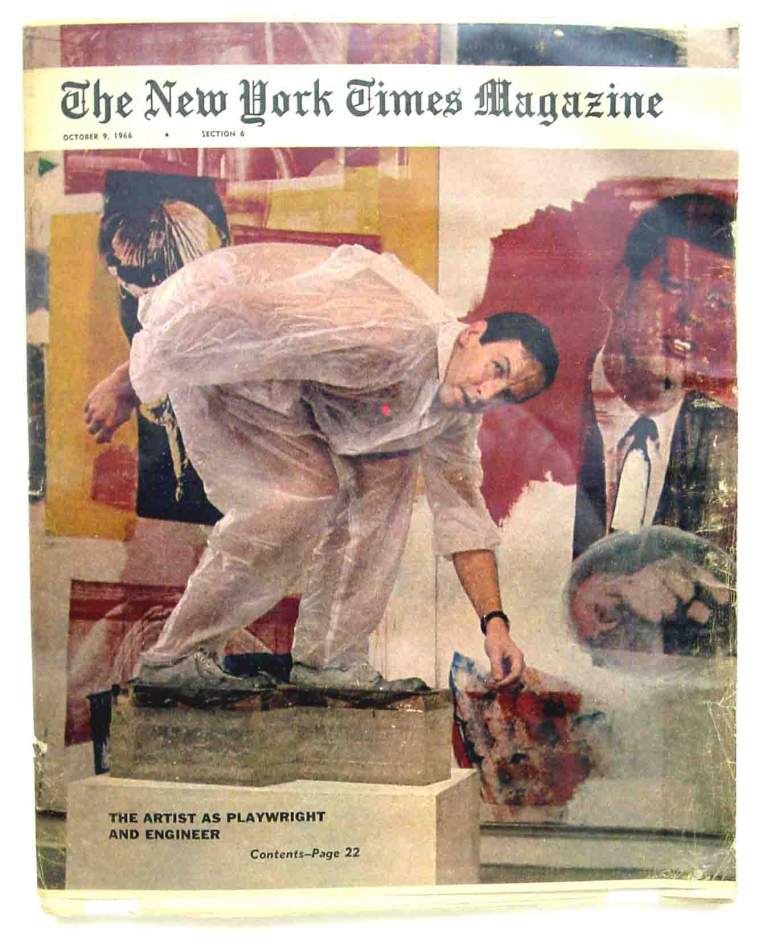1960-69
1966
January 10–12: Performs in Steve Paxton’s Proxy (1962) and Section of a New Unfinished Work: Augmented (modified from Section of an Unfinished Work, 1965) in A Dance Concert of Old and New Works, Judson Dance Theater, Judson Memorial Church, New York.
January 14: First meeting between artists and engineers for the performance festival 9 Evenings: Theatre & Engineering to be held in October.
February 26: Dedication of Artist’s Peace Tower, Los Angeles, one of the first and most dramatic efforts of an art movement protesting the Vietnam War. More than 400 artists attach their paintings to the 58-foot-tall tower, built by sculptor Mark di Suvero in an empty lot rented with funds contributed by Rauschenberg and CPLY (William Copley). Despite pro-war groups continually threatening its existence, thousands of people will come to the site during its three-month installation. Money raised through the sales of the works (about $12,000) is donated to the Los Angeles Peace Center.
March 29, 30: Performs with Alex Hay in Deborah Hay’s Serious Duet, A Concert of Dance by Trisha Brown and Deborah Hay, Judson Dance Theatre, Judson Memorial Church, New York.
April 13, 20: Participates in Five Choreographers in Three Dance Concerts, sponsored by the Los Angeles County Museum of Art, Rollerdrome, Culver City, California. Performs in his works Map Room II (1965) (April 13) and Pelican (1963) (April 20).
April 22: Participates in a site-specific performance of Deborah Hay’s Hill (1965) with Hay and Paxton at the reflecting pool of the Los Angeles County Museum of Art, as part of Five Choreographers in Three Dance Concerts. Rauschenberg, Hay, and Paxton were invited to Los Angeles by the director of the museum, James Elliot. While there, they attended Elliot’s wedding on a bare mesa overlooking the city. Paxton recounts that after the ceremony the couple mounted a motorcycle and “drove off into the future,” adding that later he learned they dismounted the cycle and actually drove a car into the future.1
April 26–May 1: NOW Festival, National Arena roller-skating rink, Washington, D.C. The festival includes performance pieces by Rauschenberg, Claes Oldenburg, Andy Warhol, and Robert Whitman. Rauschenberg performs in premiere of Linoleum and in Pelican (1963) (both April 26), and in Deborah Hay’s Serious Duet (April 29). Paxton performs his Earth Interior, where performers are invited to contribute events around and inside a 100-foot polyethylene tunnel 8 feet in diameter. Rauschenberg is photographed in the tunnel with Paxton, but was not an “invited contributor.” Linoleum, choreographed by Rauschenberg, features plastic suits wired for sound by engineer Cecil Coker; a performer eating fried chicken and pushing himself and a few live chickens across the stage in a wire-mesh cage on wheels; and motorized sculptures by Robert Breer. Rauschenberg projects his film Canoe (1966), created by editing footage from a found film. Linoleum will be performed and videotaped in the studios of WNET Channel 13, New York, for television broadcast.
Also during the last week in April, Indiana Congressman John Brademas hosts a lunch for artists and politicians, many of whom are in Washington for the NOW Festival. Among those included are John Cage, Billy Klüver, Yvonne Rainer, Rauschenberg, Robert Whitman, Metropolitan Museum of Art curator Henry Geldzahler, and U.S. Senator Jacob Javits.
May–June: Art in America issue with cover designed by Rauschenberg. The design, a collage of photographs of Ohio and works from the Cleveland Museum of Art’s collection, honors the museum’s fiftieth anniversary.
June 28: As part of the television program U.S.A. Artists, National Educational Television presents “Robert Rauschenberg,” featuring conversations with Rauschenberg and Leo Castelli, and footage of Rauschenberg at work in his studio and in performances.
August 19–October 16: Participates in the 68th American Exhibition, Art Institute of Chicago. Exhibits Oracle (1962–65), for which he is awarded the Norman Wait Harris Silver Medal and prize of $2,500.
Fall: With renovations complete, moves into the building at 381 Lafayette Street, New York, which becomes both his working and living space.
September 25: With Klüver, engineer Fred Waldhauer, and Whitman, cofounds Experiments in Art and Technology (E.A.T.), New York. The organization seeks to promote the use of technology for nonindustrial purposes by arranging collaborations between artists and engineers, creating “the possibility of a work which is not the preoccupation of either the engineer, the artist, or industry, but the result of the exploration of the human interaction between these three areas.”2 As vice president, Rauschenberg will assist in fundraising and organizing events and meetings. In September 1968, he will become chair, a position he will hold until 1972. By 1969, E.A.T. will have forty chapters in the United States and abroad.
September 29: Press conference announcing 9 Evenings: Theatre & Engineering, held in the chapel at Rauschenberg’s Lafayette Street studio. Speakers included Cage, Öyvind Fahlström, Deborah Hay, Klüver, and Rauschenberg.
October 9: Dressed in the plastic costume he wore in Linoleum and the Arman shoes he wore in Map Room II (1965), Rauschenberg appears on the cover of the New York Times Magazine, containing Richard Kostelanetz’s profile of Rauschenberg, “The Artist as Playwright and Engineer.”
October 13–16, 18–19, 21–23: 9 Evenings: Theatre & Engineering, 69th Regiment Armory, New York. Performers in the series include Rauschenberg, Cage, Lucinda Childs, Fahlström, Alex Hay, Deborah Hay, Paxton, Rainer, David Tudor, and Whitman. Rauschenberg designed the festival’s poster and choreographed Open Score (October 14 and 23). The performance features a tennis match played with rackets that are wired for sound; with each impact of the tennis ball, the armory lights shut off one by one until the space becomes completely dark and the large screens of a closed-circuit, infrared television system reveal to the audience the cast of over 500 performers who have quietly assembled onstage. Rauschenberg also performs in Alex Hay’s Grass Field (October 13 and 22), Deborah Hay’s Solo (October 13 and 23), and Fahlström’s Kisses Sweeter than Wine (October 21 and 22).3
November 10: Participates in “Is Easel Painting Dead,” a symposium in the Critics Colloquium series, New York University. Other panel members include Walter Darby Bannard, Donald Judd, and Larry Poons; Barbara Rose is moderator.
November 30: Speaks at the first meeting of E.A.T., Broadway Central Hotel, New York, attended by 300 people.
December 6–10: With Alex Hay and Paxton, organizes and participates in benefit exhibition for E.A.T. at Leo Castelli, New York, to recoup expenses from the 9 Evenings event. Rauschenberg contributed an interactive sculptural costume comprised of a Salvation Army thrift shop overcoat (previously used in an Oldenburg happening) with objects hanging from the left side, including a lightbulb, a Blue Cleaner can, and a cardboard box, and topped with a scrap-metal headpiece. An old sneaker resting on a pillow accompanies the assemblage. For a donation, visitors don the modified coat and put their right foot in the sneaker. Rauschenberg then photographs them with a Polaroid camera.
- 1. E-mail correspondence from Deborah Hay, July 2, 2014, and from Steve Paxton, July 3, 2014, with Julia Blaut. Hay was the first to mention the details of the wedding, which were further clarified by Paxton.
- 2. Quoted in Hopps, Robert Rauschenberg, p. 45.
- 3. The collaborations at the festival resulted in about nineteen new patents obtained by the engineers.

 Herb Schneider, Rauschenberg, Lucinda Childs, L.J. Robinson, Per Biorn and Billy Klüver in Berkeley Heights, NJ, preparing for *9 Evenings: Theatre and Engineering*, Berkeley Heights, New Jersey, 1966. Photo: Attributed to Frances Breer
Herb Schneider, Rauschenberg, Lucinda Childs, L.J. Robinson, Per Biorn and Billy Klüver in Berkeley Heights, NJ, preparing for *9 Evenings: Theatre and Engineering*, Berkeley Heights, New Jersey, 1966. Photo: Attributed to Frances Breer


 Rauschenberg on the cover of October 9, 1966 issue of The New York Times Magazine wearing Linoleum (1966) costume and Map Room II (1965) shoes
Rauschenberg on the cover of October 9, 1966 issue of The New York Times Magazine wearing Linoleum (1966) costume and Map Room II (1965) shoes
